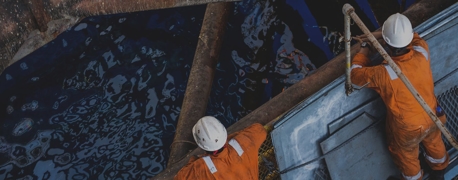The Stressful Life of an Oil Spill Responder

Oil spills pose one of the biggest threats to the environment. When a spill happens, whether as a result of an offshore drilling rig explosion, boat collision, grounding, or illegal dumping, most of the oil will float on the surface of the water. It will spread quickly and may finally become a thin, iridescent sheen. In fact, it only takes about a quart of oil to spread over an area of two acres on the ocean’s surface. Sea life, including fish, birds, and other marine animals, will be in immediate danger of suffocation or poisoning. Oil spills have long-term effects as well, disrupting delicate ecosystems and harming industries like commercial fishing and tourism in affected areas.
While it’s unfortunate that the profession exists in the first place, oil spill response is going to be necessary until spills no longer happen. The people who dedicate their lives and careers to oil spill response and clean-up are essential to protecting the environment and everyone in it.
What does it mean to be an oil spill responder? What risks do they face, and what can be done to improve safety in the industry? These are questions we will consider in this article.
What Do Oil Spill Responders Do?
According to the National Oceanic and Atmospheric Administration (NOAA), oil spill responders work to stop the source of the flow, protect sensitive areas that could be significantly harmed, and remove the oil from the environment. At sea, this might involve operating booms to contain an oil slick and skimmers to remove the oil from the water’s surface so it can be properly disposed of. Less frequently, the oil may be burned off the surface using a method called situ burning. Chemicals can also be used to break the oil into small droplets, removing it from the surface.
On land, oil spill responders may rinse the oil from the shoreline into the water to be collected, vacuum oil from the shoreline and water’s surface, use specialized materials that work like sponges to absorb just oil, or use shovels and other hand tools to remove contaminated sand or soil.
The method will depend on the location of the spill, how much oil has spilled, and what areas are at the highest risk of exposure. Most often, responders use a combination of methods to clean up an oil spill.
While responding to a spill, oil cleanup workers may work for about 8 hours a day for 7 to 14 days straight.
Oil Spill Responder Accidents & Injuries
The workers who take part in oil spill cleanup operations may be at risk of experiencing serious injuries or even death as a result of drowning, chemical exposure, falls, and heatstroke, according to the Occupational Safety and Health Administration (OSHA). Even local wildlife can pose threats to workers who are performing cleanup operations after an oil spill. Cleanup sites themselves can be considered hazardous waste sites, which brings forth even more concerns about preventing exposure.
Extreme Temperatures
Oil responders may face extreme temperatures during cleanup efforts. Heat stress, heat exhaustion, and heatstroke can occur in warmer temperatures, and in cold weather, workers may experience injuries like cold stress, hypothermia, frostbite, and trench foot (immersion foot). While they’re working at sea, oil responders may also face hazards posed by wet weather and rough seas. Employers must provide responders with the right personal protective equipment (PPE) and training to deal with hot or cold temperatures. Setting work and rest cycles can also prevent injuries caused by heat stress or cold stress.
Chemical Exposure
While handling an oil spill, responders may encounter various types of crude oil. These contain known carcinogens (cancer-causing substances) like benzene, naphthalene, and toluene. Workers may inhale or ingest these substances if proper measures are not taken to prevent exposure. Skin contact can also prove dangerous, causing burns or even skin cancer if exposure is prolonged or repeated.
Particularly in the first 24 to 48 hours after a spill, oil responders will be at risk of inhaling benzene and other toxins that evaporate into the air.
If responders use burning as a cleanup method after an oil spill, they may be at risk of inhaling nitrogen dioxide and sulfur dioxide, which are released when crude oil burns. Nitrogen dioxide can cause lung damage, respiratory irritation, and eye irritation. Sulfur dioxide can increase asthma symptoms and aggravate existing heart conditions. It can also cause respiratory damage when inhaled.
Oil responders may also be exposed to carbon monoxide and carbon dioxide, both of which can be deadly.
Containment Boom Injuries
Containment booms are large, flexible barriers that float on the water’s surface to stop oil slicks from spreading or reaching sensitive environments. These booms are reusable and must be decontaminated between uses. They are also extremely heavy and cumbersome and can be difficult to move and work with. Oil spill workers may be at risk of experiencing heavy lifting injuries or harm from being struck by or caught in booms or the equipment used to lift, lower, and maneuver them.
Drowning
As with any occupation that is conducted on or near the water, drowning is a potential hazard. Oil cleanup workers should be provided with personal flotation devices (PFDs). If a worker should fall into water that is contaminated with oil, the risk of injury from inhaling or ingesting chemicals and of drowning are greater. PFDs can help a worker stay afloat to call for help, await rescue, or get to an area where they can pull themselves out of the water.
Slip & Fall Accidents
Responders may be in danger of experiencing serious injuries if they slip and fall on oil slick surfaces, including rocks or debris on the shore as well as boat decks, ladders, steps, and other areas of the maritime vessels that respond to oil spills. Wet weather can increase the chances of slips and falls. On deck, an accident of this kind can even lead to a fall overboard into oil-contaminated water.
Trench Foot
Oil spill responders may work in the water or in wet conditions for long periods of time, and this increases the chances of an extremely painful injury called trench foot. Trench foot causes symptoms like tingling, itching, swelling, and numbness in the feet. If ignored and untreated, blisters will form and the tissue may die and fall off. Prevention is the best way to prevent trench foot, with proper footwear and by changing socks as needed to keep the feet warm and dry. Air drying and elevating the feet after a shift can also help.
Fatigue & Stress
The pressure is on when you’re working as an oil spill responder. Working long shifts and many days in a row is hard enough, but it can be overwhelming at sea or onshore where workers are exposed to the elements and potentially hazardous substances. Oil spill cleanup is also highly physical. Workers may be at risk of experiencing injuries from fatigue and stress in their efforts to handle a spill. The best ways to avoid injuries of this kind are ensuring proper rest breaks, nutrition, and water, and by working in teams, where workers can watch out for one another.
Other Injuries
Some of the other injuries that oil spill responders may experience include:
- Sunburn and sun exposure
- Insect-borne illnesses caused by mosquitoes, chiggers, spiders, or ticks
- Injuries caused by alligators, snakes, and other reptiles native to the area
- Injuries caused by ill, injured, or territorial animals
- Injuries caused by skimmers or vacuums used to remove oil from the water
- Hearing loss caused by loud equipment
- Injuries caused by poisonous plants like poison sumac or poison ivy
Employers are required to provide safe working environments, even in fields like oil spill response. They must provide workers with the proper training and equipment to do their jobs, and they must ensure that the machinery that workers use is properly maintained. In oil spill cleanup operations, that includes the vessels and equipment used to clean up spills.
Who Is Responsible for Oil Spill Response Operations?
According to the Environmental Protection Agency (EPA), “By law, the parties responsible for the use, transportation, storage, and disposal of hazardous substances and oil are liable for costs. This liability applies to the cost of containment, cleanup, and damages resulting from a release related to their own activities.”
When a company refuses to cooperate or cannot be identified, the EPA and other members of the National Response System will step forward and handle the spill as quickly as possible. The federal government also established two funds, the Superfund and the Oil Spill Liability Trust Fund, to cover the costs of cleanup activities when the at-fault party does not pay.
Helping Oil Spill Responders & Their Families
At Arnold & Itkin, we have dedicated a significant portion of our practice to representing the interests of maritime workers and their families. We are known as one of the leading offshore injury firms in the country, and our experience in this field means we know just how disastrous an oil spill can be. We know how hard seamen, longshoremen, and oil spill responders work to get their jobs done, only to be endangered by big companies that are more interested in turning profits than protecting workers and the environment.
If you work as an oil spill responder, you have the right to a safe workplace. You deserve to have the equipment and training that will help you avoid harm. As maritime attorneys, we are here to protect your rights and interests after any type of on-the-job injury. No matter what.
- Categories


